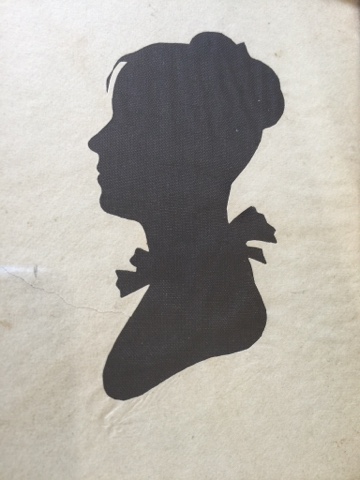Friday, February 19, 2016
Trading Silhouette Shades
Saturday, February 13, 2016
The Cutting Styles of American Silhouette Artist Baron Scotford
Monday, February 8, 2016
How to Distinguish a Real Peale Silhouette from a Counterfeit.
A thin metal stylus was employed as the drawing tool for impressing the scaled down profile image onto the paper (see figure 3 on the pantograph). The artist would then use this imprint as their guideline to work from, and could easily modify the profile as they saw fit whilst cutting it out from the center of the paper.
In 1802, John Isaac Hawkins, who was born in England in 1772 and who lived in Philadelphia, Pennsylvania, patented the second official physiognotrace, and partnered with Charles Willson Peale to market it to prospective buyers. John Hawkins's machine differed from Chrétien's in that it traced around the actual face with a small bar connected to a pantograph that reduced the silhouette to less than 2 inches. At that time, many versions of these instruments were being used all over the East Coast in the United States, some of which predated Hawkins's, and which were capable of quickly making machine-made profiles.
By 1802, in response to the popularity of silhouettes, which were invented in the late eighteenth century, Peale introduced the British inventor John Hawkins’s (1772–1855) physiognotrace at his museum in Philadelphia. While the operator traced the sitter’s head, the mechanism impressed the image onto a piece of paper that was often folded to produce multiple portraits. The operator then cut away the center of the paper, leaving a “hollow cut” image. These silhouettes, or profiles as they were also called, could be kept loose, framed, or compiled in albums; a black or blue piece of paper or fabric placed behind the image provided contrast.
Fake Peale Museum Silhouettes are easy to spot once you know what to look for!
America's leading Silhouette expert, Peggy McClard, chimes in on the subject.
Spotting fake "PEALE'S MUSEUM" silhouettes:
The most faked silhouettes in the world have the impressed signature "PEALE'S MUSEUM" under a spread eagle. That is because, in the early 20th century, a couple of unscrupulous antiques dealers named Collins found the original stamp. They set about making horribly cut fakes and stamping them with what had been one of the most rare of stamps from Charles Willson Peale's Museum. The fakes are easy to spot (although they come up for sale all the time as original pieces). First, the silhouette cutting is sloppy and the subjects are quite often George Washington and other great statespersons. Second, the paper used by Peale's real tracing machine was 3 1/2" x 4 3/4". The size of Peale's paper could not vary because his tracing machine was set up to hold a 3 1/2" x 4 3/4" piece of paper and automatically reduce the size of the profile while it was being traced around the actual person. The fake silhouettes are on paper that tends to be 6" x 8"....it is impossible that this size paper was used in Peale's tracing machine. Last, the impressed signature stamp for the real silhouettes sits right below the bust line termination....it had to because the paper was not much bigger than the actual cut profile. The impressed stamp on the fake Peale's sits well below the bust line termination....in an apparent effort to even out the extra expanse of blank space created by such a large piece of paper (even though the figures were cut much larger than the real Peales). The fake Peale's Museum silhouettes are very predominant in the market while the real ones are quite scarce.
For more information, please visit these excellent links:
Silhouettist Bios page http://peggymcclard.com/justforfun/silhouettist_bios.asp?action=view&aid=1. (Click, then scroll down to the information on Peale).
Other information links:
http://www.antiquesandfineart.com/articles/article.cfm?request=189.
http://cool.conservation-us.org/coolaic/sg/bpg/annual/v18/bp18-07.html
These Silhouettes are all from the private collection of Kathryn Flocken. Please visit www.PaperPortraits.com and send an email to Kathryn if you would like to borrow any of these photos or information for educational purposes




























































